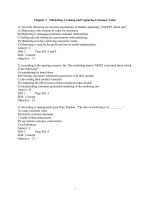Lecture Principles of Marketing - Chapter 1: Marketing: Creating and capturing customer value
Bạn đang xem bản rút gọn của tài liệu. Xem và tải ngay bản đầy đủ của tài liệu tại đây (1.59 MB, 36 trang )
i t ’s good
and
good for you
Chapter 1
Marketing:
Creating and Capturing Customer
Value
Copyright © 2012 Pearson Education, Inc.
Publishing as Prentice Hall
11- 11
Creating and Capturing Customer
Value
•
•
•
•
•
•
•
•
Topic Outline
What Is Marketing?
Understand the Marketplace and Customer
Needs
Designing a Customer-Driven Marketing Strategy
Preparing an Integrated Marketing Plan and
Program
Building Customer Relationships
Capturing Value from Customers
The Changing Marketing Landscape
Copyright © 2012 Pearson Education, Inc.
Publishing as Prentice Hall
1- 2
What Is Marketing?
Marketing is a process by which
companies create value for customers
and build strong customer relationships
to capture value from customers in return
Copyright © 2012 Pearson Education, Inc.
Publishing as Prentice Hall
1- 3
What Is Marketing?
•
The Marketing Process
Copyright © 2012 Pearson Education, Inc.
Publishing as Prentice Hall
1- 4
Understanding the Marketplace
and Customer Needs
•
Customer Needs, Wants, and Demands
Copyright © 2012 Pearson Education, Inc.
Publishing as Prentice Hall
1- 5
Understanding the Marketplace
and Customer Needs
•
•
Market offerings are
some combination of
products, services,
information, or
experiences offered to a
market to satisfy a need
or want
Marketing myopia is
focusing only on existing
wants and losing sight of
underlying consumer
needs
Copyright © 2012 Pearson Education, Inc.
Publishing as Prentice Hall
1- 6
Understanding the Marketplace
and Customer Needs
•
•
Customer Value and Satisfaction
Expectations
Copyright © 2012 Pearson Education, Inc.
Publishing as Prentice Hall
1- 7
Understanding the Marketplace
and Customer Needs
Exchange is the act of obtaining a
desired object from someone by offering
something in return
Copyright © 2012 Pearson Education, Inc.
Publishing as Prentice Hall
1- 8
Understanding the Marketplace
and Customer Needs
Markets are the set of actual and
potential buyers of a product
Copyright © 2012 Pearson Education, Inc.
Publishing as Prentice Hall
1- 9
Designing a Customer-Driven
Marketing Strategy
Marketing management is the art and
science of choosing target markets and
building profitable relationships with them
–
–
What customers will we serve?
How can we best serve these customers?
Copyright © 2012 Pearson Education, Inc.
Publishing as Prentice Hall
1- 10
Designing a Customer-Driven
Marketing Strategy
•
Selecting Customers to Serve
Market segmentation refers to dividing
the markets into segments of customers
Target marketing refers to which
segments to go after
Copyright © 2012 Pearson Education, Inc.
Publishing as Prentice Hall
1- 11
Designing a Customer-Driven
Marketing Strategy
•
Choosing a Value Proposition
Value proposition
Set of benefits or
values a company
promises to deliver to
customers to satisfy
their needs
Copyright © 2012 Pearson Education, Inc.
Publishing as Prentice Hall
1- 12
Designing a Customer-Driven
Marketing Strategy
•
Marketing Management Orientations
Copyright © 2012 Pearson Education, Inc.
Publishing as Prentice Hall
1- 13
Designing a Customer-Driven
Marketing Strategy
•
Marketing Management Orientations
Production concept is the idea that
consumers will favor products that are
available or highly affordable
Copyright © 2012 Pearson Education, Inc.
Publishing as Prentice Hall
1- 14
Designing a Customer-Driven
Marketing Strategy
•
Marketing Management Orientations
Product concept is the idea that
consumers will favor products that offer
the most quality, performance, and
features. Organization should therefore
devote its energy to making continuous
product improvements.
Copyright © 2012 Pearson Education, Inc.
Publishing as Prentice Hall
1- 15
Designing a Customer-Driven
Marketing Strategy
•
Marketing Management Orientations
Selling concept is the idea that
consumers will not buy enough of the
firm’s products unless it undertakes a
large scale selling and promotion effort
Copyright © 2012 Pearson Education, Inc.
Publishing as Prentice Hall
1- 16
Designing a Customer-Driven
Marketing Strategy
•
Marketing Management Orientations
Marketing concept is the
idea that achieving
organizational goals
depends on knowing the
needs and wants of the
target markets and
delivering the desired
satisfactions better than
competitors do
Copyright © 2012 Pearson Education, Inc.
1- 17
Publishing as Prentice Hall
Designing a Customer-Driven
Marketing Strategy
•
Marketing Management Orientations
Societal marketing concept
is the idea that a company
should make good marketing
decisions by considering
consumers’ wants, the
company’s requirements,
consumers’ long-term
interests, and society’s longrun interests
Copyright © 2012 Pearson Education, Inc.
Publishing as Prentice Hall
1- 18
Designing a Customer-Driven
Marketing Strategy
Copyright © 2012 Pearson Education, Inc.
Publishing as Prentice Hall
1- 19
Preparing an Integrated Marketing
Plan and Program
The marketing mix: set of tools (four Ps)
the firm uses to implement its marketing
strategy. It includes product, price,
promotion, and place.
Integrated marketing program:
comprehensive plan that communicates
and delivers the intended value to chosen
customers.
Copyright © 2012 Pearson Education, Inc.
Publishing as Prentice Hall
1- 20
Building Customer Relationships
•
Customer Relationship Management (CRM)
•
Copyright © 2012 Pearson Education, Inc.
Publishing as Prentice Hall
The overall process of
building and maintaining
profitable customer
relationships by delivering
superior customer value
and satisfaction
1- 21
Building Customer Relationships
•
Relationship Building Blocks:
Customer Value and Satisfaction
Copyright © 2012 Pearson Education, Inc.
Publishing as Prentice Hall
1- 22
Building Customer Relationships
•
Customer Relationship Levels and
Tools
Copyright © 2012 Pearson Education, Inc.
Publishing as Prentice Hall
1- 23
Building Customer Relationships
The Changing Nature of Customer
Relationships
•
•
•
Relating with more carefully selected
customers uses selective relationship
management to target fewer, more
profitable customers
Relating more deeply and interactively
by incorporating more interactive two
way relationships through blogs,
Websites, online communities and
social networks
Copyright © 2012 Pearson Education, Inc.
Publishing as Prentice Hall
1- 24
Building Customer Relationships
•
The Changing Nature of Customer
Relationships
Customer-managed relationships
Marketing relationships in which
customers, empowered by today’s new
digital technologies, interact with
companies and with each other to shape
their relationships with brands.
Copyright © 2012 Pearson Education, Inc.
Publishing as Prentice Hall
1- 25









